Gordes 作者: 来源: 发布时间:2021-09-26
I.Population and Area
Region: Provence-Alpes-Côte d'Azur
Department: Vaucluse
Code Insee : 84050
Code postal : 84220
Total Area: 48.04km²
Population in 2017: 1773
Population Density: 37 /km²
Location: The altitude of the city hall of Gordes is approximately 340 meters. Its surface area is 48.04 km². The latitude and longitude of them are 43.912 degrees North and 5.201 degrees East. The towns and villages close to Gordes are: Saint-Pantaléon (84220) at 3.63 km, Joucas (84220) at 4.46 km, Cabrières-d'Avignon (84220) at 4.65 km, Murs (84220) at 5.59 km, Beaumettes (84220 ) at 5.71 km.
Histogram of demographic change
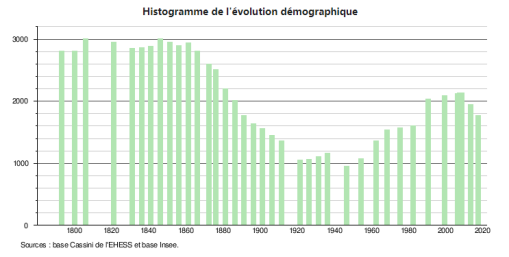
Sources :http://www.cartesfrance.fr/carte-france-ville/84050_Gordes.html
II.Natural Geography
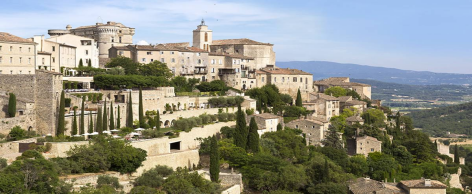
Geographical environment: Gordes is located in the center of the Vaucluse department, on the southern flank of the Vaucluse mountains, overlooking the Calavon valley from the top of a rocky peak and facing the Luberon mountain.
Geology:With a wide variation of the land, geology of the commune is divided into several distinct zones. In the north, on the Vaucluse Mountains, are soils dating mainly from Upper Jurassic with urgonian limestone and calcareous clay. There are also, in very low amounts and primarily localized over the Senanque Abbey, soils dating from the Eocene / Oligocene, composed of limestone, sand, and clay. Geology in the south of the village is more complex. The plain in Gordes (southeast) is composed of soil dating from the Quaternary and soils of the Late Jurassic period. The hills area of "les garrigues" (in the south) is composed of soil dating from the Cretaceous–Paleocene period and from the Miocene period. Finally, the soil of the territory down to the plain of Calavon with some slightly higher ground dating from the Miocene and one lower from the Quaternary.
Climat: Gordes has a Mediterranean climate characterised by relatively dry summers and cool, damp winters. The city is often subject to windy weather; the strongest wind is the mistral. In summer, high temperatures associated with a reduced amount of rain creates a drought of almost one or two months a year.
Transport:
(1) Traffic in the city: The main access road to Gordes is the D2 departmental road coming from Cavaillon then the D15 departmental road which continues north on Murs after passing through the village. It is from this road, over the Bel-Air rock, that we can observe the best known and the most photographed viewpoints over the village.
(2) Trains: Gordes is located 38 kilometers east of Avignon and its TGV station. The nearest SNCF stations are at L'Isle-sur-la-Sorgue and Cavaillon.
(3) Airport: Although there are private and hotel heliports in the area and an aero club in Cabrières-d'Avignon near the town, Gordes has none. The closest airport offering regular flights abroad is Avignon, then for a large international airport, Marseille Provence.
III.Economy
Gordes Accounting income in 2018 was 902 150 €, or 499 € per inhabitants.
Self-financing capacity in 2018 was 1 227 870 €, or 679 € per inhabitants.
Income: According to Insee, in 2014, the inhabitants of Gordes earn on average € 2 685 net per month, or € 32 216 net per year, much higher than average income in France.
Unemployment rate: In 2016, its unemployment rate was 12.4%, which was higher than the French average of 11%.
Companies: In 2017, the total number of companies in Gordes was 334, and there were 25 new companies.
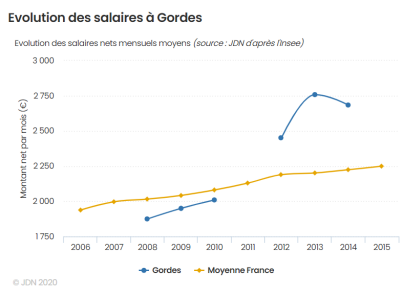
Evolution of average monthly net wages
Sources :http://www.journaldunet.com/management/ville/gordes/ville-84050/budget
http://www.journaldunet.com/management/ville/gordes/ville-84050/emploi
IV.Industrial Characterisitics
The main industries of Gordes are tourism, hand-made, and agriculture.
Tourism: Tourism is a major part of the local economy of Gordes. Accommodating the tourist trade, there are a number hotels, bed and breakfasts, seasonal rentals, and restaurants.Gordes also has two centers of relaxation, numerous pools and ponds and miles of hiking trails. It is said that Hayao Miyazaki's "Castle in the Sky" was created based on Gordes.
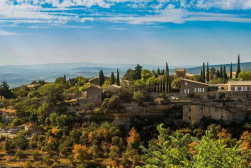
Agriculture: As in many villages in the Vaucluse department, agriculture is important. Historically, almond trees were the most planted in the area, and though they are still present, olive trees have largely replaced them. Thus olive oil is important to local commerce. You can also find vineyards, with the production of table grapes or wine in AOC Ventoux.
Commercial activity and handcraft: Commercial activity is also important in the Gordes economy with various shops including several shops dedicated to tourists, selling souvenir and regional products (figurines, textiles, olive oil, honey, etc.). Moreover, a Provençal market is held every Tuesday morning around the castle. Gordes also attracts artisans and traders in the real estate business like agents, architects, builders, landscapers, decorators, masons. By the way, the oldest real estate agency of the north Luberon area still in activity is located in Gordes, between the castle and the church, and the total number of real estate agents on the Gordes area is over ten. Market day occurs in Gordes once a week. On Tuesday mornings, merchants from the area set up booths and sell their wares. These typically include food, clothing, instruments, Provençale dishes, decorations, and handicrafts. Additionally, the village has two bakeries and a variety of shops.
V.Attractions
1. The Sénanque Abbey
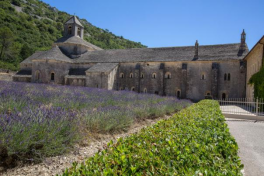
The Sénanque Abbey is a Cistercian monastery founded in 1148 under the patronage of Alfant, bishop of Cavaillon, and Ramon Berenguer II, Count of Barcelona, Count of Provence, by Cistercian monks who came from Mazan Abbey in the Ardèche. Temporary huts housed the first community of impoverished monks. By 1152 the community already had so many members that Sénanque was able to found Chambons Abbey, in the diocese of Viviers. Snug in the valley’s hollow, the Sénanque Abbey remains one of the purest examples of Cistercian architecture.
The site was repurchased in 1854 for a new community of Cistercian monks of the Immaculate Conception, under a rule less stringent than that of the Trappists. The community was expelled in 1903 and departed to the Order's headquarters, Lérins Abbey on the island of St. Honorat, near Cannes. A small community returned in 1988 as a priory of Lérins. The monks who live at Sénanque grow lavender (visible in front of the abbey, illustration, right) and tend honey bees for their livelihood since the end of the 1960s. It is possible for individuals to arrange to stay at the abbey for spiritual retreat. Two other early Cistercian abbeys in Provence are Silvacane Abbey and Le Thoronet Abbey; with Sénanque, they are sometimes referred to as the "Three Sisters of Provence".
The 12th century building is open for guided tours: abbey church, cloister, dormitory, calefactory (or warming room), and chapter house. It adheres to the spirit of Saint Benedict's Rule, "they will only truly be monks when they live from the work of their own hands." A community of Cistercian monks still lives there today.
Website: http://www.senanque.fr
Location: Abbaye Notre-Dame de Sénanque, 84220 Gordes, France
Source: https://www.gordes-village.com/en/patrimoine,musee,senanque-abbey,155.html
2.The Village des Bories
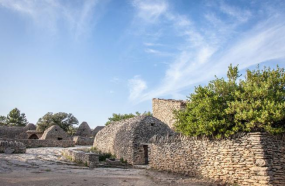
Village des Bories is an open-air museum of 20 or so dry stone huts located 1.5 km west of the Provençal village of Gordes, in the Vaucluse department of France. The area was once an outlying district of the village, under the official name of 'Les Savournins', while the grouping of huts were called 'Les Cabanes' in local parlance.
4 kilometres from the village of Gordes, on the slopes of the Vaucluse Mountains, facing the Luberon, the village of Bories (curious constructions made from dry stones), built at the beginning of the 17th century is evidence of the exceptional quality of the ancestral art of building and know-how in the stacking of stones, that has since disappeared.
In the struggle to find new land for farming during the 17th and 18th centuries, the thousands of tons of stones extracted from the ground to make room for crops changed the face of the countryside with the appearance of clapas (piles of stones extracted from the ground), walls, enclosures, restanques or terraces, and stone cabins.
There are nearly 400 bories around Gordes, located mainly on the hillsides. Secluded or forming small hamlets, they were used as shelters for shepherds or farmers and even as temporary living quarters often far from the village. In these areas where nature has reclaimed its rights and that are now deserted, try to imagine a life completely devoted to farming.
A National Heritage Site since 1977, it was awarded the prestigious Medal of the French Academy of Architecture for its restoration.
Website: levillagedesbories.com
Location: Village des Bories Les Savournins, 84220 Gordes, France
Source: https://www.gordes-village.com/en/patrimoine,musee,village-des-bories,156.html
https://en.wikipedia.org/wiki/Village_des_Bories
3.The Cellars of the Saint Firmin Palace
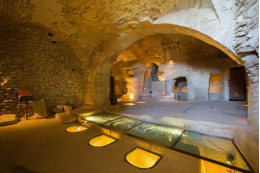
A National Heritage Site, this semi-troglodytic site was both built by man and carved out of the rock, offers visitors a journey to the heart of the Gordes’s hidden history, thanks to the presence of archaeological remains of the village’s activities during the Middle Ages (olive oil mill, silos, cisterns, etc.) An enchanting and mysterious site that is absolutely a place to visit!
In the 16th century, during the Vaudois wars, the city was spared and some found refuge in the cellars.Most of this underground place housed a very large olive oil mill which probably operated until the end of the 18th century.
Under the Revolution, the owner at the time, president of the apostolic chamber of Comtat Venaissin, François Marie de Gaudin de Lancier, warned at the last minute of the arrival of armed men, was able to leave his home thanks to this underground network.
Closer to home, the clearing of certain levels attests to their use during the war. From 1960 to 2000, forty years of clearing work, which has not yet been completed, proved necessary in order to open the place to the public and showcase its past activity.
Website: www.caves-saint-firmin.com
Location:
Source: https://www.gordes-village.com/en/patrimoine,musee,the-cellars-of-the-saint-firmin-palace,152.html
http://caves-saint-firmin.com/historique/
4.Castle of Gordes

For 1,000 years, the castle’s imposing proportions have dominates the valley and given the village its appearance as an impregnable citadel. First mentioned in 1031, the medieval fortified castle was redesigned and extended in the 14th century when the region was under attack by the troops of Raymond de Turenne. But the coming of the Renaissance and the dream of a new way of life helped transform the feudal castle into a more welcoming dwelling. Thus, beginning in 1525, Bertrand Rambaud de Simiane, whose powerful family reigned over most of the Luberon villages, was the first to start transforming the castle.
The lords of Gordes never lived in the castle and were happy to just collect the revenues from the seigneury. It was used as a prison, a warehouse for storing harvests and to house garrisons. At the end of the 19th and beginning of the 20th centuries, it was at the heart of the village life; there was a bar, school for boys, school cafeteria, post office, pharmacy and town hall.
From 1970 to 1994, the large halls housed the Vasarely educational museum, followed by the Pol Mara museum, a contemporary Flemish artist, from 1995 to 2011. The monumental Renaissance chimney is remarkable for its dimensions as well as the quality and beauty of its sculptures.
Today the castle is a cultural centre dedicated to exhibitions.
Location: Château de Gordes, 84220 Gordes, France
Source: https://www.gordes-village.com/en/patrimoine,musee,the-castle,157.html
5.Saint Firmin church
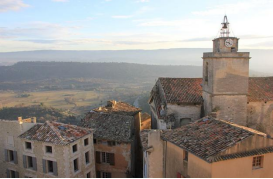
The church dedicated to Saint Firmin, patron saint of the village, was built in the 18th century. At that time, Gordes’s population was large and the medieval church became too small and was demolished along with about twenty homes to make room for the church present today. The imposing building looks like a fortress on top of the rock and gives the village its citadel-like appearance. The interior is remarkable for its wood panelling and colourful murals. Restoration work was undertaken in 2017 to restore this building to its former glory.
Location: Eglise Saint-Firmin,84220 Gordes, France.
Source: https://www.gordes-village.com/en/patrimoine,musee,saint-firmin-church,158.html
6.Calades
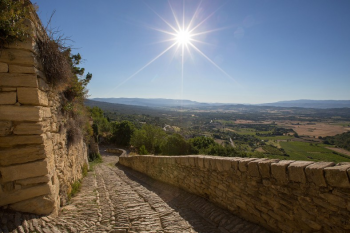
In Provence, a "calade" is a cobblestone street paved with limestone stones placed vertically on their edge. A street paved in donkey step fashion is a paved street with large successive encased landings separated by very low steps, the length of which is calculated in such a way that the next step is approached from the animal’s other hoof. These steps made it easier for the many donkeys and mules to walk in Gordes since they were the only way to carry heavy loads in the steep, narrow streets.
Source: https://www.gordes-village.com/en/patrimoine,musee,calades,160.html
VI.History
Gordes developed from the 11th century onwards around the castle to become a true fortress protected by ramparts during the turbulent periods of the Middle Ages. The powerful Provençal family Simiane d' Agoult marked Gordes’s history during the Renaissance in the person of Bertrand Rambaud de Simiane who in the 16th century remodelled and enlarged the castle.
The modern era is hard-working and industrious. Agriculture remains the essential activity, but most often it does not meet the needs of the population. In the village, craft activities are developing: silk spinning mills, tanneries, shoemaking, and wool weaving which provide work and enable many Gordians to improve a difficult daily life.
In the 18th and early 19th centuries, the village had a large population that rivalled that of the neighbouring towns, but despite a dynamic of handicrafts, especially shoemaking, poverty and disease remained a scourge. And although assistance was provided to the poor, infant mortality remained high.
From the end of the 19th century until the beginning of the 20th century, Gordes suffered great upheavals–successive earthquakes resulting in destruction, industrial change, the arrival of diseases that weakened agriculture, World War I, the Great Frost of 1956–which led to population decline and impoverishment of the inhabitants, the majority of whom fled to neighbouring towns.
However, in the 1950s, after a dry period, the town's destiny gained momentum. A group of artists, sensitive to the beauty of the village, fell under its charm and found in its isolation, its ruins, its light and its landscapes, a source of inspiration.
Sources: https://www.gordes-village.com/en/discover,history,151,55.html
VII.Other information
The stone houses and the cobbled streets of Gordes have been a source of inspiration for many painters and photographers (in particular Marc Chagall, Jean Deyrolle, Georges Feher and Willy Ronis).
Gordes is classified as one of the Most Beautiful Villages in France, is a popular destination of international renown. Its history, its heritage and architectural richness, its breath-taking panoramas, protected landscapes and nature are as many invitations to discover this little Provençal jewel. Gordes rises up like a citadel, offering a view of the landmarks of its past, a majestic protective castle, a massive church with its defensive appearance, surrounded by tall buildings that overlook the precipice and the narrow streets that make it possible to escape the assaults of the Mistral wind.
However, Gordes is not rewarded as a “town of art and history” or “flower town”.
Sources : https://www.gordes-village.com/en/discover,history,151,55.html
VIII.Contact information
Address of Gordes town hall:
Mairie de Gordes
Place du Château
Hôtel Simiane
84220 Gordes
Phone number: 04 90 72 02 08
Fax: 04 90 72 04 39
E-mail: gordes@wanadoo.fr
Website: http://www.gordes-village.com
Mayor : Maurice Chabert (Mandat : 2014-2020)
Sources : http://www.cartesfrance.fr/carte-france-ville/84050_Gordes.html#mairie
